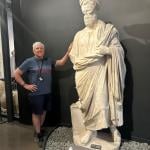The much-hyped remake of Carl Sagan’s TV documentary series Cosmos premiered on Sunday, replete with much-improved special effects, up-to-date scientific marvels, and an introduction by President Barack Obama. But a major theme of the series is apparently to beat back creationists of every stripe.
From Bradford Thomas, at TruthRevolt:
The host of Seth MacFarlane’s new series Cosmos: A Spacetime Odyssey, astrophysicist Neil deGrasse Tyson, argues that while religion and science can be compatible, religious scriptures like the Bible should not be confused with scientific textbooks, something he says “enlightened religious people” understand.
Cosmos—which features an introduction by President Obama—has already stirred controversy with a lengthy segment in the first episode which deliberately pits religion against science, providing an animated story about the Catholic Church’s persecution of the 16th-century monk and astronomer Giordano Bruno, which TIME argues provides a clear message to viewers: “there is a right side and a wrong side of intellectual history, and Cosmos is not afraid to say that science is on the right one.”
The thing is, though, the series completely confused the history of Giordano Bruno. He wasn’t burned as a heretic for asserting the existence of “multiple worlds”–as if he anticipated today’s multiple universe hypotheses, though without any kind of scientific evidence for his assertions–but for his numerous theological heresies. Details after the jump.
From Becky Ferreira, What ‘Cosmos’ Got Wrong About Giordano Bruno, the Heretic Scientist | Motherboard:
As a longtime Giordano Bruno fangirl, I had trepidations when I heard that his excruciating life story would be put front-and-center of the pilot. Though he is one of the most fascinating thinkers of his time (and that’s a seriously competitive category), his story is often mangled by the impulse to try to pin it neatly into a parable. But there is only one consistent thing about Bruno: the more you try to peg him down, the more he resists categorization.
Thankfully, the reboot did a pretty good job of covering its butt by shoehorning in some of Bruno’s contradictions, like the fact that he was a crappy scientist (and many historians argue he shouldn’t be considered one at all). They even hit upon what is fundamentally extraordinary about Bruno: that he managed to divine the universe’s plurality with no hard evidence. The guy not only figured out that stars are distant suns from pure intuition, he staked his life on it (bad pun, I know). By including these subtleties, the new pilot was far more historically accurate than Sagan’s segment on Hypatia, which oversimplifies her life almost to the point of facepalming.
Still, you’d need a whole series to really flesh out Bruno’s weirdness, so we’re going to take a crack at filling in two big gaps that Cosmos: A Spacetime Odyssey missed. The first is his legitimacy as a science martyr, an archetype he is commonly strong-armed into. Last night’s episode not only reinforced that reputation, but relished in it, playing up the violent tensions between the Catholic Church and Renaissance scientists.
But the truth is that Bruno’s scientific theories weren’t what got him killed. Sure, his refusal to recant his belief in a plurality of worlds contributed to his sentence. But it’s important to note that the Catholic Church didn’t even have an official position on the heliocentric universe in 1600, and support for it was not considered heresy during Bruno’s trial.
On top of that, his support for Copernican cosmology was the least heretical position he propagated. His opinions on theology were far more pyrotechnic. For example, Bruno had the balls to suggest that Satan was destined to be saved and redeemed by God. He didn’t think Jesus was the son of God, but rather “an unusually skilled magician.” He even publicly disputed Mary’s virginity. The Church could let astronomical theories slide, but calling the Mother of God out on her sex life? There’s no doubt that these were the ideas that landed Bruno on the stake.












